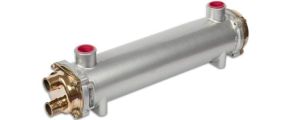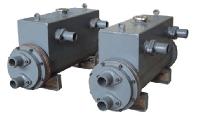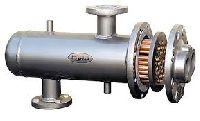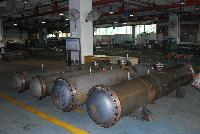
Marine Heat Exchanger
Get Price Quote

Oil Coolers Heat Exchangers
Get Price Quote
Oil cooler are classified in to two. One is air cooled - oil cooler then water –cooled oil cooler. Air cooled oil coolers are mostly used where water availability is scarce and expensive. Water-cooled oil cooler, maintenance and operating cost are usually low. The cooled water manifolds, charges oil and air coolers for usage on marine engines. These heat exchangers are suitable for power steering, bow thrusters ,deck machinery etc. Application Oil Coolers are used for various applications involving cooling of Oils, Industrial Oil Coolers heat exchangers are widely used in refrigeration, power plants, air conditioning, processing of natural gas, chemical plants, petroleum refineries and petrochemical plants. Plastic Machinery Hydraulic Power Packs Marine oil cooler
Best Deals from Industrial Heat Exchanger

Oil Coolers Heat Exchangers
Get Price Quote
Gireesh offer a wide range of oil coolers in different designs. These are compact and sleek and have constant flat fin and tube heat exchangers. Perfect for economic cooling operations where there is shortage of water, these can be customized in terms of size and units as per the clients’ requirements. We provide a wide range of oil cooler which are mainly used in heat transfers of fluids, lubricating, transformer & high pressure circuits to cool items which are 100°c or higher. These tube oil coolers are present with following features. features: • oil has a higher boiling point than water, so it can be used to cool items 100°c or higher • used in heat transfers of fluids, lubricating, transformer & quenching oils • designed for high pressure circuits • oil is an electrical insulator, so it can be used inside of or in direct contact with electrical components • heat exchanger is a piece of equipment built for efficient heat transfer from one

Marine Heat Exchanger
20,000 - 50,000 Per Piece
1 Piece (MOQ)

Marine Heat Exchanger
Get Price Quote
The Marine Heat Exchangers, which we offer, are available in the tubular form, or with an integral header tank, and models are available to suit engines of various outputs. This Marine Heat Exchanger is acclaimed for fast cooling of the marine engine. We are a dependable Manufacturer, Supplier and Exporter of Marine Heat Exchanger. Construction This Marine Heat Exchanger has a bundle of tubes, where two cooling circuits meet and exchange the heat. This bundle of tubes could be in the cooling circuit of an engine (Marine Heat Exchanger), the oil circuit (oil cooler) or intake air (inter cooler). There is a boat that we can supply with a heat exchanger to suit from the smallest petrol or diesel engine to large V8 petrol and medium-range diesels; Vertical Mounting with Integral Header Tank Horizontal mounting with Integral Header. We can manufacture the Tank of Marine Heat Exchanger, using modular construction from standard components. Design : As per ASME Section VIII Div. 1, TEMA RCB, IS 2825 & IS 4503. Capacity : As per Customer Requirements/standard Design Material of Construction : Size ranging from 3� to 100� in diameter & 40� (Feet) in length.

Marine Heat Exchanger
Get Price Quote
Marine heat exchangers are the most common way to cool a boat’s engine, using the lake, river or ocean water in which the boat floats. Since this water may be corrosive the engine may be cooled by a sealed mixture of distilled water and antifreeze. Heat from the water-antifreeze mixture is then transferred to the ocean (or lake or river) water which flows into a heat exchanger. The water-antifreeze mixture runs through the heat exchanger dumping heat, but remaining separate from corrosive salts and chemicals found in the water the boat is floating in. If the ocean water eventually corrodes and ruins the heat exchanger it can be replaced at a fraction of the cost of replacing the engine. To protect the marine heat exchanger from corrosive salts, a sacrificial zinc anode is screwed into the heat exchanger. This anode must be periodically replaced as part of regular maintenance. Because the water the boat floats in may be contaminated with floating particles such as wood or styrofoam balls the well designed boat will have a filter (often stainless steel mesh) to remove these particles before they are moved toward the heat exchanger. This filter must be periodically cleaned or else the flow of water to the heat exchanger will become obstructed and the engine will overheat. Marine Uses:- A water-jacketed exhaust manifold is necessary on marine engines to reduce the temperature of the engine-room air space and the exhaust pipe. If the exhaust manifold is in the sea-water circuit it should be installed with the sea-water inlet at the back and the outlet at the front on the top to ensure that it operates completely full of sea-water. If the manifold is in the fresh-water circuit a small by-pass hole must be provided in the thermostat to ensure that some water is circulating through the manifold at ail times. Our development is to combine a water jacketed exhaust manifold with the heat exchanger and header tank. This arrangement is particularly suitable for small series-produced engines; the manifold is cooled by fresh water and as a result a keel-cooled engine can be made by omitting the heat exchanger tube stack and the sea-water pump. On installation the fresh-water outlet from the manifold would be connected to the keel pipes and the return taken back to the engine fresh-water pump. Heat exchanger/manifold assemblies are heavier than ordinary marine manifolds and must therefore be supported on the underside using the fixing lugs provided. When automotive engines are being converted for marine use the existing centrifugal-type pump should be retained for the fresh-water circuit and an additional pump fitted for the sea-water circuit. The sea water pipe bore should be chosen so that the velocity does not exceed 2 m/sec on the suction side and 3 m/sec on the discharge side of the pump. Specifications : Large ships usually carry evaporating plants to produce fresh water, thus reducing their reliance on shore-based supplies. Steam ships must be able to produce high quality distillate in order to maintain boiler-water levels. Diesel engined ships often utilise waste heat as an energy source for producing fresh water. In this system, the engine cooling water is passed through a heat exchanger, where it is cooled by concentrated sea water. Because the cooling water (which is chemically treated fresh water) is at a temperature of 70-80 degrees C, it would not be possible to flash off any water vapour unless the pressure in the heat exhanger vessel was dropped. Partial evaporation is achieved and the vapour passes through a demister before reaching the condenser section. Sea water is pumped through the condenser section to cool the vapour sufficiently to precipitate it. Applications : The distillate gathers in a tray, from where it is pumped to the storage tanks. A Salinometer monitors salt content and diverts the flow of distillate from the storage tanks if the salt content exceeds the alarm limit. Sterilisation is carried out after the evaporator. Evaporators are usually of the shell-and-tube type (known as an Atlas Plant or of the Plate Type such as the type designed by Alfa Laval. Temperature, production and vacuum are controlled by regulating the system valves. Sea water temperature can interfere with production, as can fluctuations in engine load. For this reason, the evaporator is adjusted as seawater temperature changes, and shut down altogether when the ship is manoeuvring. Advantages : An alternative in some vessels, such as naval ships and passenger ships, is the use of the Reverse Osmosis principle for fresh water production instead of evaporators. If the engine is being used to drive auxiliary equipment in a ship and the sea water supply is taken from the ship’s main, ensure that the recommended flow rate cannot be exceeded. To alleviate this problem, a brine-air ejector venturi is used to create a vacuum inside the vessel.

Oil Coolers Heat Exchangers
Get Price Quote
We are proud to introduce ourselves as one of the leading Industrial Oil Cooler Manufacturers from India. We have outstanding information and communication technologies that have made us one of the top notch air Oil Cooler and engine oil cooler manufacturers in India. Our hi-tech plant and use of best quality raw materials help us to generate oil cooler that are industry benchmark of innovation and quality. We are flawless in our efforts to provide uninterrupted services to our clients and this hade made us one of the revered oil cooler exporters from India. We produce Hydraulic Oil Coolers which are packed floating head type in general and are suitable for figment of the return line of a Hydraulic oil system. The hydraulic oil coolers designed by us are used extensively in power packs, presses, dredgers, plastics injection equipment and a number of other hydraulic systems. Oil cooler can be connected to through hoses to the high-performance blocks by removing the plugs above the oil filter pad. It also contributes to lowering the engine-temperature. Of the three engine cooling systems (air, water, and oil), oil cooling is the most promising for getting big cooling gains with relatively little effort. It is necessary to keep the temperature of the oil, needed for the functioning of the engine and its subsystems, under control. Too high temperatures lead to a rapid degradation of the oil's lubrication characteristics with the risk of damaging mechanical parts. They may be designed to exchange heat between oil and air rather than oil and the coolant in the engine cooling circuit. The latter involves simplified oil circuits and low costs if compared to the oil-air solutions, which offer higher performances and do not imply an additional thermal load for the radiator. Hydraulic Oil Coolers are used in variety of industries for desired applications. From standard to highly specialized, these units come in a full range of sizes and materials. These units are usually specified as floating head (TEMA type "W") with O-Ring and weep hole for early leak detection. The units can be designed to ASME Section VIII, Div 1, API 612, 618,618, & 660, TEMA Class R, C & B as well as customer supplied specifications. Heat Exchanger-Oil Cooler can be obtained at most competitive prices of the industry. Our product range: Water Heat exchanger Oil coolers After cooler Condensers Fuel oil heaters Evaporators Steam – Air heaters Re – Boilers Water heater Marine heat exchanger Marine oil cooler Availability: One/Two/Three/ Four/ Six and Eight Passes Oil Coolers Applications Diesel Engines Marine Plastic Machinery Hydraulic Power Packs Other Industrial applications We offer engine oil coolers, which is an attachment in a Radiator bottom tank. These engine oil coolers cool Oil present in an Automatic transmission engine gear box. The transmission engine oil coolers designed and manufactured by us are used widely in a number of industrial applications worldwide. These oil coolers are designed according to various National and International quality standards and are very efficient. Continuous quality testing of these coolers during production ensures their high efficiency and low maintenance cost. We manufacture transmission engine oil coolers designed for effective heat transfer. These transmission engine oil coolers are design specific and vary in diameter, length, effective length and connector construction etc. The features of these industrial oil coolers are as follows. Oil Coolers Features: High performance Maximum Heat Transfer Light weight Durable Leak Proof Our ranges of high performance oil coolers are designed to keep the oil cool while maintaining its lubricating properties. This ensures smooth performance of the machine and long life of the engine. These oil coolers can be easily installed outside the radiator. We also specialize in designing special oil for towing or high performance applications. A heat exchanger has a core provided with passages for a liquid to keep cool and passages for a cooling medium, a first collection tank for supplying the liquid, a second collection tank for withdrawing the liquid, at least one third collection tank, the core being divided into at least two sections through which the liquid successively flows and which are interconnected by the at least one third collection tank, one of the sections being connected with the first collection tank, while the other of the sections being connected with the second collection tank, a bypass line connected with the third collection tank and in parallel with the other sections, and structure for activating and deactivating the bypass lines. Hydraulic Oil Coolers are suitable for heat transfer fluids, lubricating, transformer & quenching oils. They are high quality products incorporating the best materials and the latest technical features. The tube stack is fully floating so that thermal stresses are minimised and it can be easily removed should cleaning be necessary Water cooled manifolds, charge air coolers and oil coolers for use on marine engines. Suitable for use with deck machinery, bow thrusters, power steering etc. fuel coolers are designed for cooling fuel on marine engines.

Marine Heat Exchanger
Get Price Quote
Marine heat exchangers are the most common way to cool a boat's/ship engine, using the lake, river or Sea water in which the boat floats. Direct cooling of the cylinders and heads by sea-water is unsatisfactory because sea water will eventually ruin the cylinder block and heads. Since this water may be corrosive the engine may be cooled by a sealed mixture of distilled/Fresh water and antifreeze. Heat from the water-antifreeze mixture is then transferred to the Sea (or lake or river) water which flows into a heat exchanger. The water-antifreeze mixture runs through the heat exchanger dumping heat, but remaining separate from corrosive salts and chemicals found in the water the boat is floating in. If the Sea water eventually corrodes and ruins the heat exchanger it can be replaced at a fraction of the cost of replacing the engine.

Marine Heat Exchanger
Get Price Quote
Hitech Equipments range of heat exchanger are marine heat exchanger, industrial heat exchanger and heat exchanger that Marine Heat Exchangerswe present has been designed and developed in adherence with various international quality Marine Heat Exchangersstandards. These have a compact design and style of construction of the plate arrangement, which allows enhanced performance in Marine Heat Exchangers.

Marine Heat Exchanger
Get Price Quote
The exchangers are very high efficient and best product. High Quality design with high heat transfer ability. The advantages and problem areas with different heat exchanger types and materials are discussed. Marine heat exchanger is its size, cost and ease of adapting existing cold water systems to hot. Researchers, over the years, have used a variety of heat exchanger types and materials. The application of heat exchangers to large scale marine aquaculture.

Steam Heat Exchanger
Get Price Quote
Water Heat Exchangers that use steam-driven turbines commonly use heat exchangers to boil water into steam. All fossil-fueled and nuclear power plants using steam-driven turbines have surface condensers to convert the exhaust steam from the turbines into condensate water for re-use.Water Heat Exchangers large power plants with steam-driven turbines, shell-and-tube surface condensers are used to condense the exhaust steam exiting the turbine into condensate water which is recycled back to be turned into steam in the steam generator.

Marine Heat Exchanger
Get Price Quote
Marine Heat Exchangers exhaust manifold is necessary on marine engines to reduce the temperature of the engine-room air space and the exhaust pipe. Our development is to combine a water jacketed exhaust manifold with the heat exchanger and header tank. This arrangement is particularly suitable for small series-produced engines; the manifold is cooled by fresh water and as a result a keel-cooled engine can be made by omitting the heat exchanger tube stack and the sea-water pump. On installation the fresh-water outlet from the manifold would be connected to the keel pipes and the return taken back to the engine fresh-water pump.

Marine Heat Exchanger
Get Price Quote
Marine Heat Exchanger, Mist Eliminators, Air Cooled Heat Exchanger

Industrial Heat Exchangers
Get Price Quote
Industrial Heat Exchangers, air blast oil coolers, Finned Tube Heat Exchanger